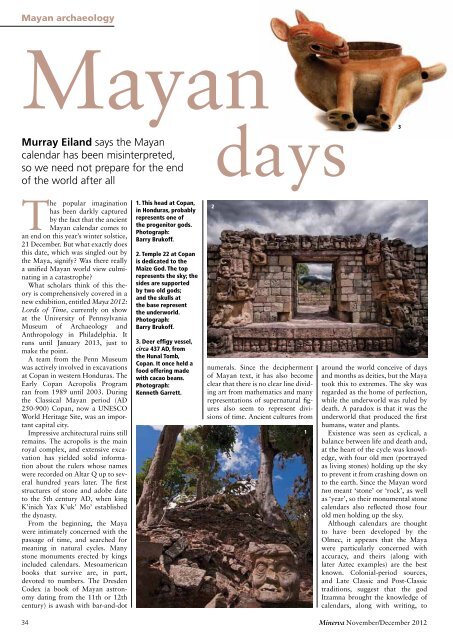Following Odysseus Not the end of the world Amarna city of light ...
Following Odysseus Not the end of the world Amarna city of light ...
Following Odysseus Not the end of the world Amarna city of light ...
- No tags were found...
You also want an ePaper? Increase the reach of your titles
YUMPU automatically turns print PDFs into web optimized ePapers that Google loves.
Mayan archaeologyMayanMurray Eiland says <strong>the</strong> Mayancal<strong>end</strong>ar has been misinterpreted,daysso we need not prepare for <strong>the</strong> <strong>end</strong><strong>of</strong> <strong>the</strong> <strong>world</strong> after all3The popular imaginationhas been darkly capturedby <strong>the</strong> fact that <strong>the</strong> ancientMayan cal<strong>end</strong>ar comes toan <strong>end</strong> on this year’s winter solstice,21 December. But what exactly doesthis date, which was singled out by<strong>the</strong> Maya, signify? Was <strong>the</strong>re reallya unified Mayan <strong>world</strong> view culminatingin a catastrophe?What scholars think <strong>of</strong> this <strong>the</strong>oryis comprehensively covered in anew exhibition, entitled Maya 2012:Lords <strong>of</strong> Time, currently on showat <strong>the</strong> University <strong>of</strong> PennsylvaniaMuseum <strong>of</strong> Archaeology andAnthropology in Philadelphia. Itruns until January 2013, just tomake <strong>the</strong> point.A team from <strong>the</strong> Penn Museumwas actively involved in excavationsat Copan in western Honduras. TheEarly Copan Acropolis Programran from 1989 until 2003. During<strong>the</strong> Classical Mayan period (AD250-900) Copan, now a UNESCOWorld Heritage Site, was an importantcapital <strong>city</strong>.Impressive architectural ruins stillremains. The acropolis is <strong>the</strong> mainroyal complex, and extensive excavationhas yielded solid informationabout <strong>the</strong> rulers whose nameswere recorded on Altar Q up to severalhundred years later. The firststructures <strong>of</strong> stone and adobe dateto <strong>the</strong> 5th century AD, when kingK’inich Yax K’uk’ Mo’ established<strong>the</strong> dynasty.From <strong>the</strong> beginning, <strong>the</strong> Mayawere intimately concerned with <strong>the</strong>passage <strong>of</strong> time, and searched formeaning in natural cycles. Manystone monuments erected by kingsincluded cal<strong>end</strong>ars. Mesoamericanbooks that survive are, in part,devoted to numbers. The DresdenCodex (a book <strong>of</strong> Mayan astronomydating from <strong>the</strong> 11th or 12thcentury) is awash with bar-and-dot1. This head at Copan,in Honduras, probablyrepresents one <strong>of</strong><strong>the</strong> progenitor gods.Photograph:Barry Bruk<strong>of</strong>f.2. Temple 22 at Copanis dedicated to <strong>the</strong>Maize God. The toprepresents <strong>the</strong> sky; <strong>the</strong>sides are supportedby two old gods;and <strong>the</strong> skulls at<strong>the</strong> base represent<strong>the</strong> under<strong>world</strong>.Photograph:Barry Bruk<strong>of</strong>f.3. Deer effigy vessel,circa 437 AD, from<strong>the</strong> Hunal Tomb,Copan. It once held afood <strong>of</strong>fering madewith cacao beans.Photograph:Kenneth Garrett.2numerals. Since <strong>the</strong> decipherment<strong>of</strong> Mayan text, it has also becomeclear that <strong>the</strong>re is no clear line dividingart from ma<strong>the</strong>matics and manyrepresentations <strong>of</strong> supernatural figuresalso seem to represent divisions<strong>of</strong> time. Ancient cultures from1around <strong>the</strong> <strong>world</strong> conceive <strong>of</strong> daysand months as deities, but <strong>the</strong> Mayatook this to extremes. The sky wasregarded as <strong>the</strong> home <strong>of</strong> perfection,while <strong>the</strong> under<strong>world</strong> was ruled bydeath. A paradox is that it was <strong>the</strong>under<strong>world</strong> that produced <strong>the</strong> firsthumans, water and plants.Existence was seen as cyclical, abalance between life and death and,at <strong>the</strong> heart <strong>of</strong> <strong>the</strong> cycle was knowledge,with four old men (portrayedas living stones) holding up <strong>the</strong> skyto prevent it from crashing down onto <strong>the</strong> earth. Since <strong>the</strong> Mayan wordtun meant ‘stone’ or ‘rock’, as wellas ‘year’, so <strong>the</strong>ir monumental stonecal<strong>end</strong>ars also reflected those fourold men holding up <strong>the</strong> sky.Although cal<strong>end</strong>ars are thoughtto have been developed by <strong>the</strong>Olmec, it appears that <strong>the</strong> Mayawere particularly concerned withaccuracy, and <strong>the</strong>irs (along withlater Aztec examples) are <strong>the</strong> bestknown. Colonial-period sources,and Late Classic and Post-Classictraditions, suggest that <strong>the</strong> godItzamna brought <strong>the</strong> knowledge <strong>of</strong>cal<strong>end</strong>ars, along with writing, to34Minerva November/December 2012
















